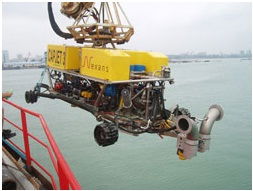Published: 11 March 2014
Category: News
Nexans has developed a range of remote operated vehicle (ROV) tether cables, known as Enable®. The cables incorporate bending optimised Dyneema fibre as the strength member. This increases bending fatigue resistence and marks an important step towards more cost-effective ROV operations.

During operation, the cable is subjected to small bending diameters and relatively sharp directional changes in the TMS as well as vehicle motions. This causes the synthetic fibres used as the strength member to mechanically deteriorate, resulting in the need for regular re-termination of the ROV tether cable.
The key innovation in the development of the Enable® cables is that the aramid fibres previously used as the strength member have been replaced by high-performance bending-optimized Dyneema® fibres. Extensive fatigue testing has demonstrated that the new Enable® cables have a bending durability that is several orders of magnitude better than conventional cables.
Improved bending performance offers a number of operator advantages
ROV operators can utilize the improved bending performance of Enable® cables in a number of ways, depending on their strategy. It is immediately apparent that they can ensure a prolonged mechanical lifetime when deployed on existing systems, with the increased intervals between re-terminations offering more cost-effective operations. Enable® cables could also offer a similar mechanical lifetime on smaller systems.
